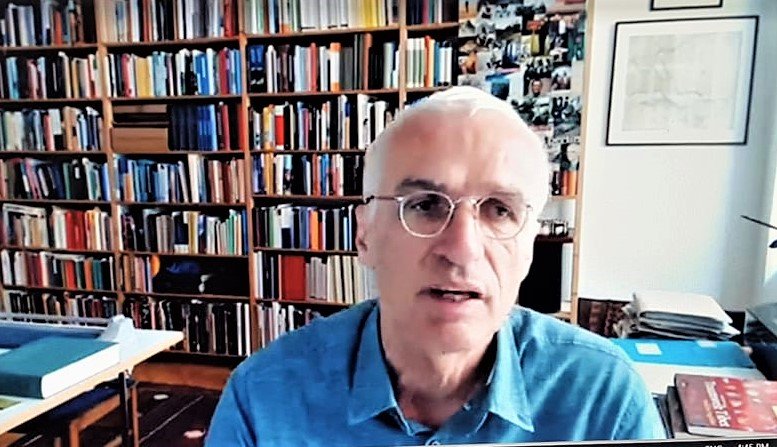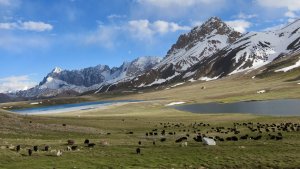Any hope for the upcoming International Year of Rangelands and Pastoralists?
By Prof Hermann Kreutzmann
The United Nations General Assembly has announced 2026 as the International Year of Rangelands and Pastoralists. Such efforts attempt to draw attention toward neglected regions and marginalised communities. What is Pakistan’s position in this? Who are the advocates for pastoralists’ causes or who are the administrators, bureaucrats, politicians, and development experts neglecting these pressing issues by non-action? In the following, some salient features of pastoralism in the development arena are addressed.
The wider Himalayan Arc, consisting of mountain ranges that incorporate major mountain systems such as the Tien Shan, Pamir, Hindu Kush, Karakoram, Himalaya, and Kun Lun Shan Mountains, is ecologically a very diverse mountainous region with peaks and plateaux. Steep mountain slopes and deeply incised valleys, glaciated areas above the snow lines, deserts and steppes, forests, rangelands, and wetlands compose a region that offers limited space for mountain communities to settle in compact oases and vast areas for extensive forms of pastoral practices herding predominantly for 16 million yaks, and much higher numbers of sheep and goats. About 60% of the Hindukush-Himalayan surface is composed of rangelands and pastures.
Mountain ranges often contain little oases for irrigated cultivation compared to partially more than half of its entire surface that can be utilised for one or the other form of animal husbandry. Consequently, it is not surprising that due to seasonal variations in fodder availability long- and short-ranging mobility has been part of human adaptation over centuries by utilising and maintaining natural resources in a sustainable manner.
The romantic vision of free-ranging nomads that have been avoiding settled and governed areas probably never existed although state evasion and freedom from exploitation and expropriation has often been their goal. Pastoral communities were as much dependent on their settled neighbours for supplies of grain and other commodities as cities and villages were markets for animal products and demanding transport services from mobile communities.
Also read: Hunza Matters: Unmaking and making
The advent of colonial powers in the Himalayan Arc resulted in a multi-lateral contest that led to designated spheres of influence and finally to the demarcation of imperial boundaries and regional borders. When delineated boundaries became efficient geopolitical instruments of state control in borderlands, it significantly affected the mobility range for pastoral communities and led to shrinking pastoral spaces. Prominent examples are the restricted movement of Afghan nomads across the Durand Line, separating nowadays Afghanistan from Pakistan, on their way from the summer pastures in the Hindukush heights to the Indus Valley during winters.
The advent of colonial powers in the Himalayan Arc resulted in a multi-lateral contest that led to designated spheres of influence and finally to the demarcation of imperial boundaries and regional borders.
Hermann KreutzmanN
The Kashmir conflict between India and Pakistan significantly affected the seasonal migration of Bakerwal pastoralists across the line of control. Many other examples are known from the Pamirs where border closures hindered pastoralists, traders, and pilgrims to cross from Russia into China or Afghanistan, or in recent years between newly independent Central Asian Republics.
Also read: Untangling Wakhan Quadrangle
Nevertheless, shrinking pastoral spaces occurred not only by interrupting migration routes, regulations, and control contributed as much as the forces of settlement expansion and modernisation strategies. The 20th century is characterised by infrastructure development, cultivation of formerly pristine lands, destruction of forests, and revaluation of natural assets, population, and settlement growth.
Archaic forms of extensive forms of pastoral practices found their anti-thesis in the spirit of modernisation and technological progress. The promoters of modernisation and resource exploitation supported a ‘modern’ mobile society but termed classical forms of mobility as outdated, backward, and refutable.
Underlying is an old and well-known cultural conflict between mobile and resident communities, which seem to be mutually suspicious about the behaviour and lifestyles of each other. Thus, the shrinking of pastoral spaces is as much a spatial phenomenon focusing on area and distance as it is a political, socio-cultural, and development theory-inspired process that has accelerated programmes of sedentarisation and settlement of mobile communities in most countries. The settling of nomads resulted in an early version of land-grabbing, expropriation of inherited resource access, and resource conversion, albeit it took place mainly within the boundaries of nation-states and promoted input-demanding forms of agriculture in order to increase material output.
In Afghanistan, processes of re-nomadisation are observed despite the high prevalence of landmines. Investors who seek a profit from mobile animal husbandry have taken the risk despite continuing and even growing insecurity and poor governance. The passing of a new pasture law seems to lead the civil path despite all kinds of growing insecurities.
In South Asian countries the adaptation and modification of their colonial legacies in pasture and forest legislation is discussed and leading the way to the challenges posed by climate change adaptation and international conventions on nature protection.
Also read: Cheesemaking in Nepal under Threat
Pastoralists are among rural dwellers who remain grossly neglected. Their marginalisation and neglect became again obvious when the International Centre for Integrated Mountain Development (ICIMOD) published its ‘Hindu Kush Himalaya Assessment’ in 2019. Mountain pastoralists are more or less absent on the 627 pages, which reflects their political position and social marginalisation.
Shrinking spaces for pastoralism are often the result of abandoning customary rules in favour of state interference under the pretext of nature protection and afforestation.
Hermann Kreutzmann
As stakeholders and actors, they are often deprived of any rights and entitlements. On the other hand, they would and need to play an important role as landscape managers in climate-change-related transformations. Shrinking spaces for pastoralism are often the result of abandoning customary rules in favour of state interference under the pretext of nature protection and afforestation. Pastoralists are losing their local markets as food production is shifting away from rural areas.
India and Pakistan have inherited rangeland management policies as a colonial legacy. Both started designing a national rangeland management policy rather late, as a side effect of new forest legislation. Their common point of reference was the ‘Cattle Trespassers Act’ of 1871 and the ‘Forest Policy’ of 1894.
In Pakistan a ‘National Rangeland Policy’ has been announced; a decision about the draft is still pending in the Forestry Departments. India envisaged a paradigm shift with the ‘National Forest Policy’ (1988), in which rangelands played an important role, followed by the 2006 ‘National Environmental Policy’.
In both countries, livestock production is supposed to be intensified to meet growing market demands in an arena of decreasing rangeland availability. Both are apparently failing to cope with the challenges. Similar statements could be made for Nepal. Only Bhutan nationalised its rangelands, redistributed pastures to its herders, and issued user certificates to pastoralists. The Kingdom of Bhutan is proactively promoting pastoralists’ livelihoods in its mountain ranges.
This brief characterisation of policies and plans reveals a varied set of attitudes towards the management of the pastoral commons within the ‘modernisation’ ideology. The ‘tragedy of responsibility’ comes in different disguises. The designs of national policies are quite different and mainly governed by national agendas and international pressure. Whether they might be an adequate and appropriate instrument to address the challenges the livelihoods of pastoralists are undergoing remains unanswered here.
Acknowledging pastoralism’s efficiency in landscape management, preservation of ecological peripheries, and utilisation of ecological niches requires state support for herding families to bring them on par with mainstream society
Hermann Kreutzmann
The International Year of Rangelands and Pastoralists offers the opportunity to design adequate and appropriate plans for the adapted use of natural wealth by extensive forms of animal husbandry. Acknowledging pastoralism’s efficiency in landscape management, preservation of ecological peripheries, and utilisation of ecological niches requires state support for herding families to bring them on par with mainstream society.
Ecosystem services do not come without a price tag, pastoralists’ expertise and contribution to landscape management has been neglected for too long. A first step would be if Pakistan would adequately be represented in international organisations and conferences that are devoted to the cause of rangelands and pastoralism.
During the preparatory conference for the International Year of Rangelands and Pastoralists in Kathmandu and organised by ICIMOD in May 2023 it seemed that Pakistan is devoid of experienced pastoralists in its mountain regions of the Hindukush, Karakoram, and Himalaya.
The wealth of expertise and generation-old professionalism among herders as landscape managers should be proactively brought to the stage to share with the world its unique and highly sophisticated approach to organise life in the mountains in a sustainable manner.
Academics, filmmakers, journalists, and media people are asked to support the cause of the mountains as one of the most cherished assets of Pakistan should be present during the International Year of Rangelands and Pastoralists in 2026.

Professor Dr Hermann Kreutzmann is an internationally-acclaimed German scholar, researcher, and author of many books including Hunza Matters, Pamirian Crossroads, and The Wakhan Quadrangle: Exploration and Espionage during and after the Great Game. He has written numerous research articles on pastoralism in Pamirs and chapters to many other books.

The High Asia Herald is a member of High Asia Media Group — a window to High Asia and Central Asia

